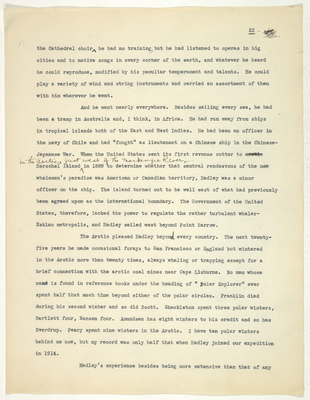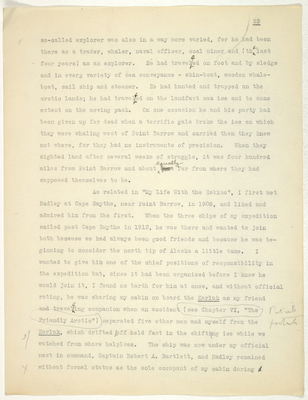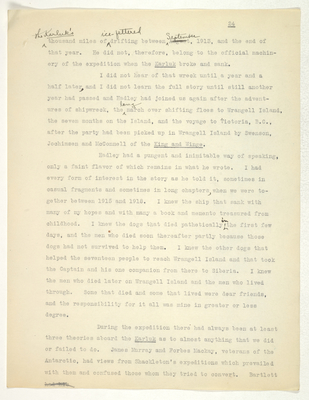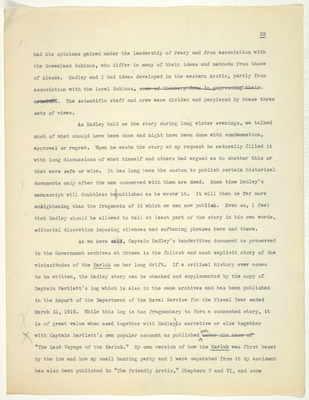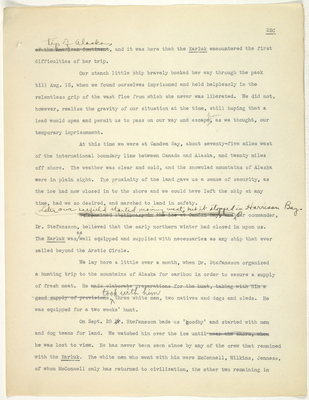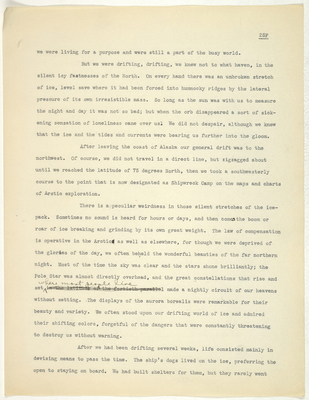Pages That Need Review
stefansson-wrangel-09-26-001
stefansson-wrangel-09-26-001-027
22
the Cathedral choir he had no training, but he had listened to operas in big cities and to native songs in every corner of the earth, and whatever he heard he could reproduce, modified by his peculiar temperament and talents. He could play a variety of wind and string instruments and carried an assortment of them with him wherever he went.
And he went nearly everywhere. Besides sailing every sea, he had been a tramp in Australia and, I think, in Africa. He had run away from ships in tropical islands both of the East and West Indies. He had been an officer in the navy of Chile and had “fought” as lieutenant on a Chinese ship in the ChineseJapanese War. When the United States sent its first revenue cutter to arctic Herschel Island in the arctic just west of the mackenzie River in 1889 to determine whether that central rendezvous of the new whalemen's paradise was American or Canadian territory, Hadley was a minor officer on the ship. The island turned out to be well east of what had previously been agreed upon as the international boundary. The Government of the United States, therefore, lacked the power to regulate the rather turbulent whalerEskimo metropolis, and Hadley sailed west beyond Point Barrow.
The Arctic pleased Hadley beyond every country. The next twentyfive years he made occasional forays to San Francisco or England but wintered in the Arctic more than twenty times, always whaling or trapping except for a brief connection with the arctic coal mines near Cape Lisburne. No man whose namd is found in reference books under the heading of "Polar Explorer" ever spent half that much time beyond either of the polar circles. Franklin died during his second winter and so did Scott. Shackleton spent three polar winters, Bartlett four, Nansen four. Amundsen has eight winters to his credit and so has Sverdrup. Peary spent nine winters in the Arctic. I have ten polar winters behind me now, but my record was only half that when Hadley joined our expedition in 1914.
Hadley's experience besides being more extensive than that of any
stefansson-wrangel-09-26-001-028
23
so-called explorer was also in a way more varied, for he had been there as a trader, whaler, naval officer, coal miner and (the last four years) as an explorer. He had travelled on foot and by sledge and in every variety of sea conveyance - skin-boat, wooden whaleboat, sail ship and steamer. He had hunted and trapped on the arctic lands; he had travelled on the landfast sea ice and to some extent on the moving pack. On one occasion he and his party had been given up for dead when a terrific gale broke the ice on which they were whaling west of Point Barrow and carried them they knew not where, for they had no instruments of precision. When they sighted land after several weeks of struggle, it was four hundred miles from Point Barrow and about equally far from where they had supposed themselves to be.
As related in "My Life With the Eskimo", I first met Hadley at Cape Smythe, near Point Barrow, in 1908, and liked and admired him from the first. When the three ships of my expedition sailed past Cape Smythe in 1913, he was there and wanted to ioin both because we had always been good friends and because he was beginning to consider the north tip of Alaska a little tame. I wanted to give him one of the chief positions of responsibility in the expedition but, since it had been organized before I knew he would join it, I found no berth for him at once, and without official rating, he was sharing my cabin on board the Karluk as my friend and travelling companion when an accident (see Chapter VI, "the
Friendly Arctic”) separated five other men and myself from-the Karluk, which drifted off held fast in the shiftipg ice while we watched from shore helpless. The ship was now under my official next in command, Captain Robert A. Bartlett, and Hadley remained without formal status as the sole occupant of my cabin during a
stefansson-wrangel-09-26-001-029
24
The Karluk's thousand miles of ice-fettered drifting between August September, 1913, and the end of that year. He did not, therefore, belong to the official machinery of the expedition when the Karluk broke and sank.
I did not hear of that wreck until a year and a half later, and I did not learn the full story until still another year had passed and Hadley had joined us again after the adventures of shipwreck, the long march over shifting floes to Wrangell Island, the seven months on the Island, and the voyage to Victoria, B.C., after the party had been picked up in Wrangell Island by Swenson, Jochimsen and McConnell of the King and Winge.
Hadley had a pungent and inimitable way of speaking, only a faint flavor of which remains in what he wrote. I had every form of interest in the story as he told it, sometimes in casual fragments and sometimes in long chapters, when we were together between 1915 and 1918. I knew the ship that sank with many of my hopes and with many a book and memento treasured from childhood. I knew the dogs that died pathetically in the first few days, and the men who died soon thereafter partly because those dogs had not survived to help them. I knew the other dogs that helped the seventeen people to reach Wrangell Island and that took the Captain and his one companion from there to Siberia. I knew the men who died later on Wrangell Island and the men who lived through. Some that died and some that lived were dear friends, and the responsibility for it all was mine in greater or less degree.
During the expedition there had always been at least three theories aboard the Karluk as to almost anything that we did or failed to do. James Murray and Forbes Mackay, veterans of the Antarctic, had views from Shackleton's expeditions which prevailed with them and confused those whom they tried to convert. Bartlett had his
stefansson-wrangel-09-26-001-030
25A
had his opinions gained under the leadership of Peary and from association with the Greenland Eskimos, who differ in many of their ideas and methods from those of Alaska. Hadley and I had ideas developed in the western Arctic, partly from association with the local Eskimos, some of themvery free in expressing their opinions. The scientific staff and crew were divided and perplexed by these three sets of views.
As Hadley told me the story during long winter evenings, we talked much of what should have been done and might have been done with condemnation, approval or regret. When he wrote the story at my request he naturally filled it with long discussions of what himself and others had argued as to whether this or that were safe or wise. It has long been the custom to publish certain historical documents only after the men concerned with them are dead. Some time Hadley’s manuscript will doubtless be published as he wrote it. It will then be far more enlightening than the fragments of it which we can now publish. Even so, I feel that Hadley should be allowed to tell at least part of the story in his own words, editorial discretion imposing silences and softening phrases here and there.
As we have said, Captain Hadley’s handwritten document as preserved in the Government archives at Ottawa is the fullest and most explicit story of the vicissitudes of the Karluk on her long drift. If a critical history ever comes . to be written, the Hadley story can be checked and supplemented by the copy of Captain Bartlett's log which is also in the same archives and has been published in the Report of the Department of the Naval Service for the Fiscal Year ended . While this log is too fragmentary to form a connected story, it is of great value when used together with Hadley's narrative or else together with Captain Bartlett s own popular account as published in under the name of "The Last Voyage of the Karluk.” My own version of how the Karluk was first beset by the ice and how my small hunting party and I were separated from it by accident has also been published in "The Friendly Arctic," Chapters V and VI, and some
stefansson-wrangel-09-26-001-031
25A account of her drift in the appendix to that book.
We can, therefore, choose between many sources for the narrative so be used now. Most logical perhaps would be to use Hadley as the basis of it all, but we have decided to tell the first part of the story in the words of Frederick Maurer. If we used any of the other versions we should have to condense for the purposes of this book; but Maurer has been so brief that we can afford to print his statement without change, except minor editing as where names are misspelled because he did not have the ship's papers when he wrote. We have also omitted a few things which were pertinent then at the time but which would now only confuse the reader, and we have corrected one or two errors into which Maurer at that time fell in common with nearly everyone else, as for instance where he refers with apparent approval conviction to the common belief at that time that I was dead because I had been absent on the ice to the north of Alaska for several months when I had "planned to be gone for only ten days." The fact was, of course, that I had planned to be gone for a year but that an incorrect report of my progranmme had been circulated in such a way that the Karluk party who had not been in personal contact with me for a year were led to believe it in common with the rest of the public.
There are reasons of sentiment also for taking part of the our story of Wrangell Island from Maurer. It was he who eventually hauled up the British flag on Wrangell Island (July 1st, 1914). By his residence of seven months on Wrangell he had been was fired with a desire to be an instrument in redeeming it from the unknown and bringing it within the circle of lands that are used and valued. Mountain climbers do not delight in their feats because they are easy, but their pleasures are not therefore less real than the lethargic joys of a winter resort. So it was with Maurer. Wrangell Island had always been to him a difficult place. There were hard times in 1914, but long well before 1921 he had begun to long for an opportunity to try himself against these same difficulties again, just as the moun-
stefansson-wrangel-09-26-001-032
25B taineer wants to return to the fastnesses where he has had perhaps his most serious greatest disappointments. Maurer had seen three of his companions die and he had dug the their graves and raised the crosses that stand on Wrangell Island. He wanted to carry on toward the work so that these men should not have died in vain, and he was fearless and even enthusiastic about it, for he felt he had learned by experience how dangers and difficulties that had formerly been serious could now be overcome. He did not persuade Knight or me into the new adventure any more than we persuaded him. But he did give us the facts of climate and conditions upon which we based our plans.
I am sorry therefore that we have to prefer even Hadley's narrative to Maurer's for the main part of the Wrangell story. That is because Hadley has left us a long document. Maurer has left only four short magazine articles that were published by the New York World on June 6, 13 , 20, and 27, 1915. Brevity dictated by the space which the magazine allowed makes the story unsuited for our uses insofar as the events after the shipwreck are concerned. But that very brevity makes it particularly suitable for the story a summary of the drift which preceded the wreck. We set it down here as published in "The World Magazine” for Sunday, June 6th, 1915:
Maurer's Narrative
The Canadian Arctic Expedition, under command of Vilhjalmur Stefansson, in the barkentine Karluk, sailed from Esquimalt, British Columbia, June 17, 1913. The purpose of the expedition was to make scientific investigations along the northern coast of Canada, to rediscover the blend Eskimos whom Stefansson reported he had met on a previous trip,and to look for new lands supposed to lie somewhere in the great uncharted sea to the north and northwest of Alaska.
On Aug. 6 the expedition passed Point Barrow, the northermost land
stefansson-wrangel-09-26-001-033
25C
of the American Continent, tip of Alaska, and it was here that the Karluk encountered the first difficulties of her trip.
Our stanch little ship bravely bucked her way through the pack till Aug. 15, when we found ourselves imprisoned and held helplessly in the relentless grip of the vast floe from which she never was liberated. We did not, however, realize the gravity of our situation at the time, still hoping that a lead would open and permit us to pass on our way and escape from, as we thought, our temporary imprisonment.
At this time we were at Camden Bay, about seventy-five miles west of the international boundary line between Canada and Alaska, and twenty miles off shore. The xireather was clear and cold, and the snowclad mountains of Alaska were in plain sight. The proximity of the land gave us a sense of security, as the ice had now closed in to the shore and we could have left the ship at any time, had we so desired, and marched to land in safety.
We remained stationary in the ice at Camden Bay, and Later our icefield started moving west, but it stopped in Harrison Bay. Our commander, Dr. Stefansson, believed that the early northern winter had closed in upon us. The Karluk was as well equipped and supplied with necessaries as any ship that ever sailed beyond the Arctic Circle.
We lay here a little over a month, when Dr. Stefansson organized a hunting trip to the mountains of Alaska for caribou in order to secure a supply of fresh meat. He made elaborate preparations for the hunt, taking with him a good supply of provisions, took with him three white men, two natives and dqgs and sleds. He was equipped for a two weeks’ hunt.
On Sept. 20 Dr. Stefansson bade us 'goodby' and started with men and dog teams for land. We watched him over the ice until near the shore, when he was lost to view. He has never been seen since by any of the crew that remained with the Karluk. The white men who went with him were McConnell, Wilkins, Jenness, of whom McConnell only has returned to civilization, the other two remaining in
stefansson-wrangel-09-26-001-034
25D
the North and continuing their work for the Canadian Government. (this was written in may, 1915)
Two days after Stefansson left us a heavy fog settled over the entire region. It was so dense that we were able to see only a few rods in any direction. Almost simultaneous with the fog, a blizzard blowing from the southeast sprang up. The fog enveloped us for three days, and being unable to take any bearings, we were wholly unconscious of any movement of our position. When the mists cleared away the shores of the continent were no longer in sight, and upon taking astronomical observations, we found that we had drifted quite a distance from our former position.
When the Karluk started on her famous drift there were twenty white men, two Eskimo men, one Eskimo woman and two children, little girls, on board. We were well supplied with provisions, coal, arms, ammunition, dogs, sleds, snowshoes and skiis, everything necessary for arctic travel. At first there did not seem to be much concern among the members of the expedition, except among the scientists. They talked among themselves a great deal as to the probable outcome of our situation. The other members indulged in many conjectures, but passed the matter over rather lightly, always expecting some turn of good fortune that would liberate us from the grip of the ice. By taking observations daily, we knew that we were skirting the shores of Alaska, and at no time very far from them, although they were never in sight. We drifted past Point Barrow in the night, passing so near that we almost touched land. Our passing was later reported to Dr. Stefansson by a native who claimed to have seen us, and I believe he did, for he stated that there was no smoke issuing from our funnels. This was true, for we had blown down our boilers some time before.
When Stefansson returned from his hunting trip he found the Karluk missing. He then made his way overland to Point Barrow, three hundred miles distant, where he wrote a telegram reporting the loss of the Karluk, and sent it by a native to Nome, four hundred miles away, which was the nearest telegraph station. We learned later that he then returned to Herschel Island, where the
stefansson-wrangel-09-26-001-035
The report of our deaths appeared in the press in September, 1914, and was universally accepted even by arctic explorers. But we got in touch with ships again in August, 1915, and the press reports of our being alive appeared in September, U. S.
Belvedere, which carried freight and additional supplies for him, was lying, and fitted out a dog sled expedition to make a dash for the unknown land which he believed lay somewhere in the uncharted area to the north of Alaska. He started with dogs and sleds taking with him two Norwegians, Storkerson and Andreasen, both experienced arctic travelers, on March 22, 1914. Up to the present time nothing further has been heard of him. (June May, 1915)
We must have passed Point Barrow some time before Stefansson arrived there, as we drifted rapidly between Camden Bay and that point, making as much as three knots an hour, or about forty miles a day, and we had probably seven or eight days the statt of him. It seems that when he lost his ship he was seized with a desperate determination not to be balked in his attempt to reach an unknown land which he believed to exist. Returning to the Belvedere, he made the dash which in its very nature was little short of suicidal. The icepack to the north of Alaska is known to be the most treacherous of in the arctic seas.
When we began drifting the sun was above the horizon about ten hours each day. By the time we passed Point Barrow we had only five hours of sunlight, and on November 15 the sun disappeared below the horizon altogether and we entered upon the|long Arctic night.
In the meantime Capt. Bartlett set about taking measures for our safety. He first had us bank up the sides of the ship with ice for the purpose of forming a kind of cushion against the lateral pressure of the floe that held us. Then we blew down the boilers and began repairing the engines. This we did by taking them apart piece by piece and replacing each as soon as it had been gone over and repairs made if needed. Capt. Bartlett had us remove all the sacked coal that we had no on deck and place it on the ice beside the ship; also all the biscuits, kerosene, alcohol, sleds and skiis. We then put the ship and the portion of the cargo that remained on her in good and snug shape and made her our living quarters. Keeping us at work as much of the time as he could was the best thing Capt. Bartlett could have done for us. As long as we were working it seemed that
stefansson-wrangel-09-26-001-036
25F
we were living for a purpose and were still a part of the busy world.
But we were drifting, drifting, we knew not to what haven, in the silent icy fastnesses of the North. On every hand there was an unbroken stretch of ice, level save where it had been forced into hummocky ridges by the lateral pressure of its own irresistible mass. So long as the sun was with us to measure the night and day it was not so bad; but when the orb disappeared a sort of sickening sensation of loneliness came over us. We did not despair, although we knew that the ice and the tides and currents were bearing us further into the gloom.
After leaving the coast of Alaska our general drift was to the northwest. Of course, we did not travel in a direct line, but zigzagged about until we reached the latitude of 75 degrees North, then we took a southwesterly course to the point that is now designated as Shipwreck Camp on the maps and charts of Arctic exploration.
There is a peculiar weirdness in those silent stretches of the icepack. Sometimes no sound is heard for hours or days, and then comes the boom or roar of ice breaking and grinding by its own great weight. The law of compensation is operative in the Arctic as well as elsewhere, for though we were deprived of the glories of the day, we often beheld the wonderful beauties of the far northern night. Most of the time the sky was clear and the stars shone brilliantly; the Pole Star was almost directly overhead, and the great constellations that rise and set where most people live made a nightly circuit of our heavens without setting. The displays of the aurora borealis were remarkable for their beauty and variety. We often stood upon our drifting world of ice and admired their shifting colors, forgetful of the dangers that were constantly threatening to destroy us without warning.
After we had been drifting several weeks, life consisted mainly in devising means to pass the time. The ship's dogs lived on the ice, preferring the open to staying on board. We had built shelters for them, but they rarely went
